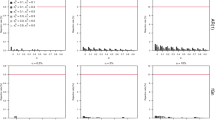Abstract
Many recent works show that copulas turn out to be useful in a variety of different applications, especially in environmental sciences. Here the variables of interest are usually continuous, being times, lengths, weights, and so on. Unfortunately, the corresponding observations may suffer from (instrumental) adjustments and truncations, and eventually may show several repeated values (i.e., ties). In turn, on the one hand, a tricky issue of identifiability of the model arises, and, on the other hand, the assessment of the risk may be adversely affected. A possible remedy is to adopt suitable randomization procedures: here three different strategies are outlined. The goal of the work is to carry out a simulation study in order to evaluate the effects of the randomization of multivariate observations when ties are present. In particular, it is investigated whether, how, and to what extent, the randomization may change the estimation of the structural risk: for this purpose, a coastal engineering example will be used, as archetypical of a broad class of models and problems in engineering applications. Practical advices and warnings about the use of randomization techniques are hence given.






Similar content being viewed by others
References
AghaKouchak A, Easterling D, Hsu K, Schubert S, Sorooshian S (eds) (2013) Extremes in a changing climate. Springer, Houten
Bücher A, Kojadinovic I (2016) n overview of nonparametric tests of extreme-value dependence and of some related statistical procedures. In: Dey D, Yan J (eds) Extreme value modeling and risk analysis: methods and applications. CRC Press, Boca Raton, pp 377–398
de Amo E, Díaz-Carrillo M, Fernández-Sánchez J (2012) Characterization of all copulas associated with non-continuous random variables. Fuzzy Sets Syst 191:103–112
De Michele C, Salvadori G, Vezzoli R, Pecora S (2013) Multivariate assessment of droughts: frequency analysis and dynamic return period. Water Resour Res 49(10):6985–6994. doi:10.1002/wrcr.20551
Di Lascio FML, Durante F, Jaworski P (2016) Truncation invariant copulas and a testing procedure. J Stat Comput Simul 86:2362–2378. doi:10.1080/00949655.2015.1110820
Durante F, Sempi C (2016) Principles of copula theory. CRC/Chapman & Hall, Boca Raton
Durante F, Fernández-Sánchez J, Quesada-Molina JJ, Úbeda-Flores M (2015) Convergence results for patchwork copulas. Eur J Oper Res 247(2):525–531
Genest C, Favre AC (2007) Everything you always wanted to know about copula modeling but were afraid to ask. J Hydrol Eng 12(4):347–368
Genest C, Nešlehová J (2007) A primer on copulas for count data. Astin Bull 37(2):475–515
Genest C, Nešlehová J (2012a) Copula modeling for extremes. In: El-Shaarawi AH, Piegorsch WW (eds) Encyclopedia of environmetrics, 2nd edn. Wiley, Chichester, pp 530–541
Genest C, Nešlehová J (2012b) Copulas and copula models. In: El-Shaarawi AH, Piegorsch WW (eds) Encyclopedia of environmetrics, 2nd edn. Wiley, Chichester, pp 541–553
Genest C, Nešlehová J, Ruppert M (2011) Discussion: statistical models and methods for dependence in insurance data. J Korean Stat Soc 40(2):141–148
Genest C, Nešlehová J, Rémillard B (2014) On the empirical multilinear copula process for count data. Bernoulli 20(3):1344–1371
Kojadinovic I, Yan J (2011) A goodness-of-fit test for multivariate multiparameter copulas based on multiplier central limit theorems. Stat Comput 21:17–30
Kojadinovic I, Yan J, Holmes M (2011) Fast large-sample goodness-of-fit tests for copulas. Stat Sin 21:841–871
Marshall AW (1996) Copulas, marginals, and joint distributions. In: Distributions with fixed marginals and related topics (Seattle, WA, 1993) (IMS lecture notes monograph series), vol 28. Institute of Mathematical Statistics, Hayward, pp 213–222
Nelsen RB (2006) An introduction to copulas, 2nd edn. Springer, New York
Pappadà R, Perrone E, Durante F, Salvadori G (2016) Spin-off extreme value and Archimedean copulas for estimating the bivariate structural risk. Stoch Environ Res Risk Assess 30:327–342. doi:10.1007/s00477-015-1103-8
Salvadori G, De Michele C, Kottegoda N, Rosso R (2007) Extremes in nature. An approach using copulas, water science and technology library. Springer, Dordrecht
Salvadori G, Tomasicchio GR, D’Alessandro F (2014) Practical guidelines for multivariate analysis and design in coastal and off-shore engineering. Coast Eng 88:1–14. doi:10.1016/j.coastaleng.2014.01.011
Salvadori G, Durante F, Tomasicchio GR, D’Alessandro F (2015) Practical guidelines for the multivariate assessment of the structural risk in coastal and off-shore engineering. Coast Eng 95:77–83. doi:10.1016/j.coastaleng.2014.09.007
Sklar A (1959) Fonctions de répartition à \(n\) dimensions et leurs marges. Publ Inst Stat Univ Paris 8:229–231
Straub D (2014) Engineering risk assessment. In: Klüppelberg C, Straub D, Welpe IM (eds) Risk—a multidisciplinary introduction. Springer, Cham
Acknowledgements
Helpful discussions with C. Genest (McGill University, Montréal (Québec), Canada), I. Kojadinovic (Université de Pau et des Pays de l’Adour, Pau, France), and C. Sempi (Università del Salento, Lecce, Italy) are gratefully acknowledged. [RP] The support of the Department of Economics, Business, Mathematics and Statistics “Bruno De Finetti” (University of Trieste, Italy), via the project FRA, is acknowledged. [FD] The support of Faculty of Economics and Management, Free University of Bozen-Bolzano, via the project “COCCO”, is acknowledged. [GS] The support of the CRM-CANSSI (Université de Montréal, Montréal (Québec), Canada), where the work originated, is gratefully acknowledged. The support of the CMCC [Centro Euro-Mediterraneo sui Cambiamenti Climatici, Lecce (Italy)] is acknowledged.
Author information
Authors and Affiliations
Corresponding author
Electronic supplementary material
Below is the link to the electronic supplementary material.
Rights and permissions
About this article
Cite this article
Pappadà, R., Durante, F. & Salvadori, G. Quantification of the environmental structural risk with spoiling ties: is randomization worthwhile?. Stoch Environ Res Risk Assess 31, 2483–2497 (2017). https://doi.org/10.1007/s00477-016-1357-9
Published:
Issue Date:
DOI: https://doi.org/10.1007/s00477-016-1357-9




